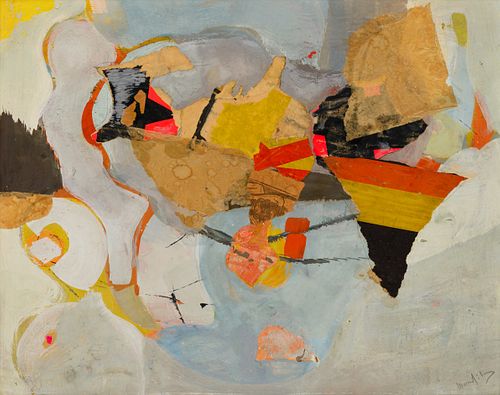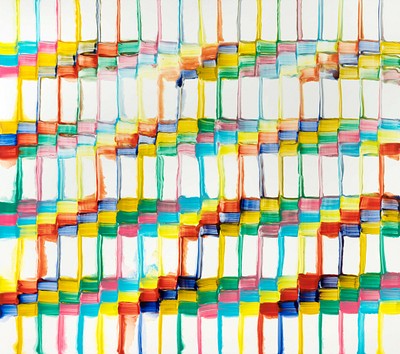Beatrice Mandelman(American, 1912-1998)Gray Clouds, 1948
Lot 73
About Seller
Hindman
1338 West Lake Street
Chicago, IL 60607
United States
Recognized as the Midwest's leading fine art auctioneers, Hindman Auctioneers has built a worldwide reputation based on a full service approach to the auction business tailored to meet the individual needs of our clients. Coming from a variety of educational backgrounds, specialists bring years of e...Read more
Estimate:
$2,000 - $4,000
Absentee vs Live bid
Two ways to bid:
- Leave a max absentee bid and the platform will bid on your behalf up to your maximum bid during the live auction.
- Bid live during the auction and your bids will be submitted real-time to the auctioneer.
Bid Increments
| Price | Bid Increment |
|---|---|
| $0 | $25 |
| $500 | $50 |
| $1,000 | $100 |
| $2,000 | $250 |
| $5,000 | $500 |
| $10,000 | $1,000 |
| $20,000 | $2,500 |
| $50,000 | $5,000 |
| $100,000 | $10,000 |
About Auction
By Hindman
May 4, 2021
Set Reminder
2021-05-04 11:00:00
2021-05-04 11:00:00
America/New_York
Bidsquare
Bidsquare : Post War & Contemporary Art
https://www.bidsquare.com/auctions/hindman-auctions/post-war-contemporary-art-6796
Hindman Bidsquare@hindmanauctions.com
Hindman Bidsquare@hindmanauctions.com
- Lot Description
Beatrice Mandelman
(American, 1912-1998)
Gray Clouds, 1948
casein with collage on masonite
signed Mandelman (lower right); titled and dated (verso)
16 x 20 inches.
Provenance:
The Artist
The Estate of Beatrice Mandelman
203 Fine Art, Taos, New Mexico
This work is accompanied by a certificate of authenticity issued by the Mandelman-Ribak Collection
Lot essay:
I am a believer in the poetry of the subconscious moving into the realm of abstraction. My work could be called ‘subjective abstractions.’ I have the freedom of choice today to let my space flow. I make room in my painting for the observer to dream.
-Beatrice Mandelman, Mandelman Shows in Taos, 1977, Santa Fe New Mexican
A prolific painter throughout her life, Beatrice Mandelman, or “Bea,” knew she wanted to be a painter from an early age. Born in Newark, New Jersey in 1912, Mandelman was introduced at an early age to Russian Constructivism and other avant-garde movements by Louis Lozowick, an artist and family friend. She began taking classes at the age of 12 at the Newark School of Fine and Industrial Art and eventually studied at both Rutgers University and the New York Art Student’s League. From 1935 to 1942, Mandelman was employed by the Works Project Administration in New York, where she became associated with numerous New York School artists including Louis Lozowick, Willem de Kooning, Arshile Gorky, Jackson Pollock, and Stuart Davis. Although Mandelman’s style was to evolve over time, she remained committed to modernism and abstraction throughout her career.
In 1944, Mandelman and her husband, Louis Ribak, settled in Taos, New Mexico. She and Ribak became a part of the group of artists known as the Taos Moderns, which included Ed Corbett, Agnes Martin, Oli Sihvonen, and Clay Spohn. Far from the strictures of the New York art scene, Mandelman found the freedom to develop a style that was distinctly her own. Inspired by the light, the local color, the landscape and the confluence of diverse cultures in Taos, her work flourished. The artist moved away from her previous, Ashcan, social-inspired scenes of the WPA period and adopted a bright, expressive version of Abstract Expressionism, often working in series. Gray Clouds, 1948, is proof of this evolution into abstraction.Condition
For condition inquiries please contact nathanbrady@hindmanauctions.com. - Shipping Info
-
Please refer to https://hindmanauctions.com/shipping-packing
-
- Buyer's Premium



 EUR
EUR CAD
CAD AUD
AUD GBP
GBP MXN
MXN HKD
HKD CNY
CNY MYR
MYR SEK
SEK SGD
SGD CHF
CHF THB
THB













